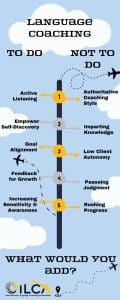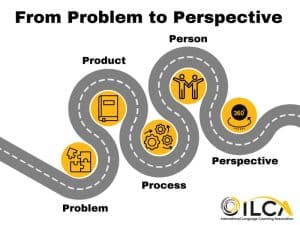TLDR: In this blog post Gabriella runs through the top 10 tips for a successful group coaching session when you do not have the luxury of a full session. She also delves into the issues that can crop up during a group coaching course.
Background:
You’ve got a group of a couple of learners that are being passive and not working in class. It is draining and as a professional, you may find it difficult to work in this situation. So these are some ideas for what to do with a passive, not particularly dynamic or energetic group, when you notice that things are just not going as they should be.
The Initial Dilemma:
You have an unmotivated group of learners in a group setting and a limited amount of time to motivate them because of external (read company or language school goals for the class). Some of the things you might be saying to yourself are:
- What do I want to do as a coach that would help them?
- I don’t have time to dig deeper into this.
- Do I need to give them more prompts to move them further?
- I don’t like having a time constraint or when too many things are going on.
- I feel overwhelmed when I don’t have time to properly delve deeper.
If you identify with these thoughts and concerns with your groups of learners, then keep reading. Below we have featured 10 tips to help you break through this dilemma and support your learners in a way that you, and they, feel comfortable with.
Tip 1: Give learners the chance to give you information about their language learning goals
One idea is to create a form or a template on a page, which gets the learners to identify some general aspects of their language learning. Because it’s in a format which is is familiar to the learners, there is no extra stress and there is time to complete, it can be done as some form of homework, or pair work even to think together, ask questions and clarify amongst themselves, even in the native language if necessary. The framework would be something that they feel comfortable with so it’s not completely new that’s one thing.
The other advantage is that you’re giving them the time and space to think about it and at least something is happening for them. The third thing is that it’s indirect. If it is too direct and you start coaching somebody in a group they are going to step back because it’s a new situation and they’ll feel uneasy, as they know that these are not the kind of questions you usually ask. So this survey may be about their satisfaction of the course so far perhaps – see what is going on for them,
– What is it you are happy with?
– What can you highlight so far?
– Do you have any favorite activities in the lessons you enjoy doing? etc.
Tip 2: Bring learner and stakeholder goals in alignment
Some initial ideas in this area might be.
– Are their goals in alignment with the stakeholder (school/company) expectations?
– Can they be brought together more?
– How can they (learners) make the company expectations their own?
Discussing this can be very helpful and move the clients forward to understanding where there could be discrepancies and how to bridge these and move forward so it is more about values and goals ultimately. After identifying these, all stakeholders can be satisfied with the outcomes.
Tip 3: Identify the real issue for the learners
Another aspect is to address whether they really have time issues (not enough during the week), if they are not committed enough to do it, or if they truly don’t have the energy for it. Maybe they have problems with the format, like having to use grammar gap-fills or other ’boring’ worksheets. So maybe they have a content or format issue.
This can easily be resolved if you start talking about it. Maybe it can be just one adjustment that they would be happy with. It’s possible that they simply haven’t formulated this thought so far because they don’t really know what to do. They just come in to class, sit around, and wait for something to happen – but, of course nothing does happen, as they are not putting in the energy or the effort and they are not interacting with each other or with you as their teacher.
Tip 4. Provoke by Providing Feedback
Another thing that you can do is be quite provocative in a way and say:
Look, I’m going to give you very honest feedback: based on the work you have done so far, I don’t see much progress is being made here. If I did an assessment or some kind of interim language test, your results would probably be exactly the same as at the beginning of our course. Your performance and the development that you have made is pretty much near zero at the moment, unfortunately and I’m giving you this feedback because I don’t want the end of the course to be similar. I want to boost you I want to help you. Do you feel we are wasting time at the moment?
Pushing them a little bit into this area of feeling bad is at times necessary, because it’s their responsibility.
Another way you can message it is I’m doing all the teaching I can, but frankly I don’t see you doing all the learning you can. Once again, the distance between your responsibilities for teaching and the responsibility for the learning needs to be made clear – you can’t learn instead of them. You can create a really good atmosphere and good environment for learning and you can explain things, you can provide handouts that they have to do – if they’re not engaging, then nothing’s going to happen.
If gradually you realise the group is not at the level they should be at, this begs the question that perhaps the assessment was not crafted well or as a teacher I did not see the signs that the students are not at a B2 level, even though they completed a B1 level course before starting this one.
How to make your language learning progress better: that’s the key focus. Giving them some reflective feedback helps immensely.
Extra Food for Thought: Are Students not the Right Fit for a Course?
This is a typical situation in teaching, where we have learners moving from one language level course to the next but in fact are not actually making progress and are not able to to jump from one language milestone to the next.
This sort of more provocative feedback can unsettle certain language learners, as they have been accustomed perhaps to a more soft and gentle approach, which, as we see, is not necessarily serving their needs. The need is to move forward to make progress and development with the language learning and at this point in the course we are let’s say halfway into it, and this aim is not being achieved.
Question to reflect on as a professional:
– Are you comfortable with being provocative with your learners?
– Are YOU okay with confronting them and doing something to support them with the answers you receive?
So lots of food for thought around assessment and what happens when you realize some way into the course that actually what you have in the syllabus is not what they need because it’s frustrating the learners and pushing them back. As we are exploring the different areas of what could be going wrong with these learners, for them to be so passive, there could be myriads of reasons, and without using coaching questions it remains a blind spot for the teacher but also maybe for the learner or a whole group even, so it is worth delving just a bit deeper.
Tip 5. Keep Boundaries
This issue can also be addressed from the perspective of what the learner expectations are about whose responsibility it is to create a learner-friendly learning environment. And very often what we can conclude from our conversations with learners is that they expect us to create a very clear, very straightforward framework into which they fit their little pieces of the puzzles that they have and everything works beautifully for them. But the truth is that the teacher, the language professional practitioner is not there to provide this very clear framework, because it’s not just a subject matter it’s not just about understanding something, learning something, actively making use of all that has been used, that is it’s all about application. And application can only be produced, so to say, through practice. So it can never be a passive process on the part of the learner.
Tip 6: Orient the learners towards the future
Try asking, suggesting to your learners:
– If there was one thing you could change in English lessons what would that be?
– What is your favourite activity? Can you share with us what you like about it?
– Compared to what we’re doing now how do you see an ideal lesson?
– Try to imagine an ideal English/German… lesson.
– What does that look like, what does that feel like, what’s happening, what am I doing as your teacher, what are you doing as the students?
Imagining an ideal situation is very powerful because it can work as an anchor and it can pull them towards that state of mind. This can also be useful in creating more positive energy in the course.
Tip 7: Find Topics that interest the learners
Try looking at things from the perspective of topics and interests relevant to the learners. This might, however, put you in conflict with the syllabus that you need to follow and the tests that you need to have them take at the end of the course.
The question is: As a coach how do we contribute to lessons to get learners to start thinking, ‘Yes, I want this. I want to do this’. We want to energize them, to bring in the positive thinking around what they can achieve and what they can do to reach their own goals. We want this, even if they are external goals set by the company or the language school. So the issue is how to internalize these and work towards them. Now this is the big question of course. As a teacher I show up for each language lesson – is that enough for the learners? To show up and that is it? No, I prepare too, so should they…
Tip 8: Create value
You could have another approach to this this group and say:
You know, I really value that you’re giving your time every week one or two or whatever hours to be here… How can we create more value in this time?
So once again going very deep very suddenly with that sort of question and keeping with the positive outlook.
Tip 9: Give objective feedback
You can of course provoke them and say I’m seeing that there’s not much going on here… Sooner or later you’re going to have to call attention to this fact and you might create a mock test similar to the one they need to take at the end of the course, based on the work you have done together. And say: I’d like you to do this at home in 30-minutes. This way they can see the results and that’s a very objective benchmark for them and they will probably see they have to speed up their learning or adjust learning practices etc.
Tip 10: Reflect on your process
Maybe, deep down, you believe that you’re not the right person. This issue is much more about the general framework of teaching and how certain groups do not fit the mould and how they’re not making the progress that they should be. It is about the external expectations of the language teaching industry, the way the courses are put together, and not any kind of feedback on what you are making efforts with to get your learners to be more collaborative and interactive in the classes.
Managing expectations as a professional is also something for many teachers to reflect on:
– What is it that needs a shift?
– Are you expecting too much or too little?
– How can moving up or down one notch on an imaginary scale impact your learners? The outcomes? The lesson work?
Group Dynamics & Mindset
You can get your learners to do these activities individually at home, in the class, give them time to reflect about it, understand the question, perhaps put them into pairs so that they can discuss among themselves – this way it’s still a kind of personal activity but they can bounce ideas off of each other, which always gives it an added perspective, a deepening of meaning perhaps. Finally you can invite them to share any ideas that have come out of this activity, being mindful of giving learner’s the option of not sharing. That’s the central idea about sharing: you only share what you feel you want to offer as an insight or a comment to all the others in the group and the teacher.
Another way to look at this is to build a very slow approach to things, because it is not going to work. Like for example: Here is the task, please do it. It simply will not work. You might be familiar with the term scaffolding, in which you start helping with brainstorming and you slowly move to providing some information, talking about a theme, then asking them to read, then listen, then write and finally speak about the theme. So moving from passive to more active skillsets gradually.
If you found this useful, do add your comments and thoughts below.






